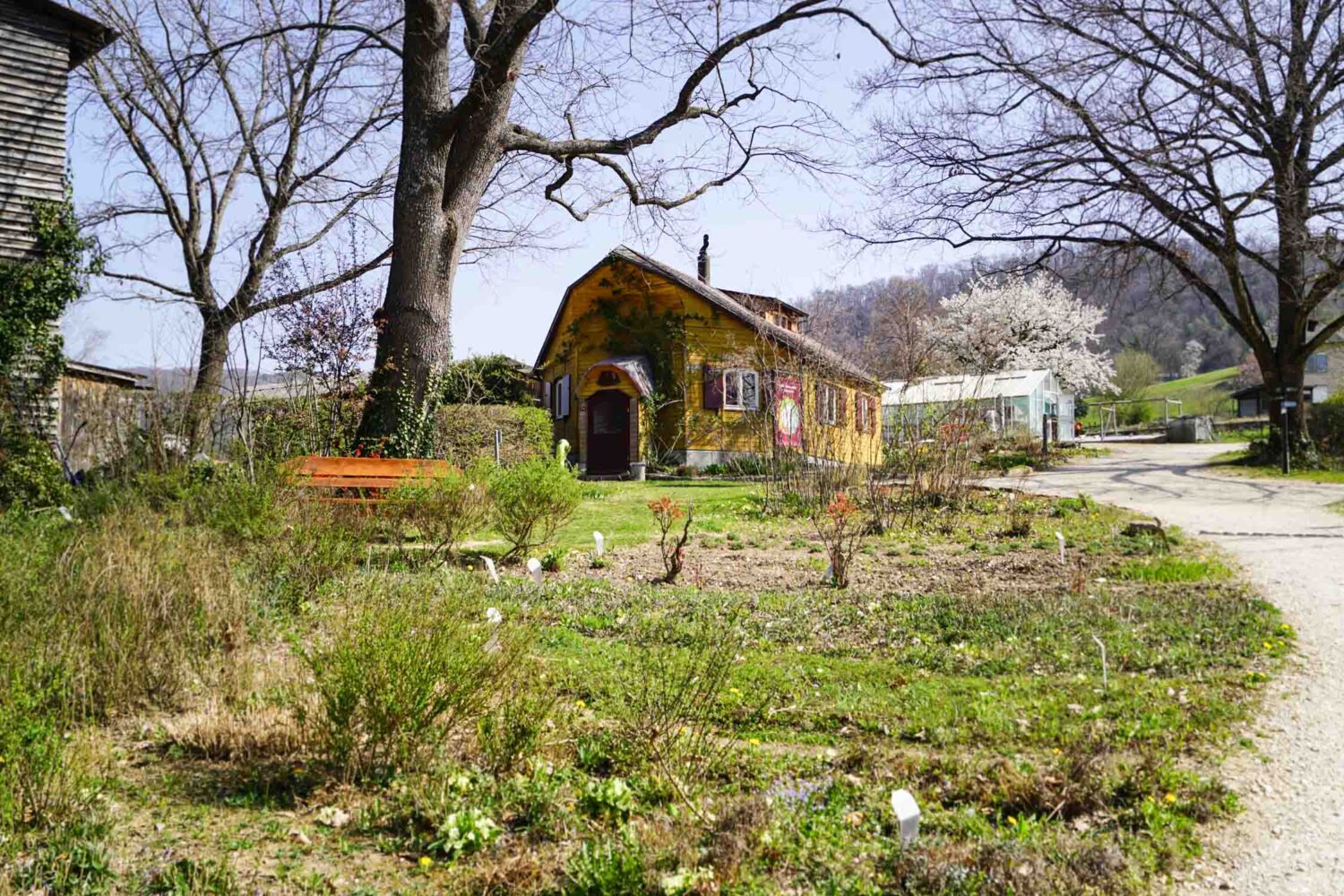The School of Spiritual Science at the Goetheanum researches contemporary questions and themes for global society as well as the origins of our existence, the evolution of humanity, Earth, and the cosmos. Indeed, grand visions are addressed, visions in which inner and outer life meet but also in which ideal and reality can clash. The effort to make a decisive, if modest, contribution to the public and scientific debate surrounding sustainability has not lost its relevance in the last hundred years—in fact, it is increasingly in demand.
The Goetheanum would like to contribute to these public and scientific debates. One such contribution in the area of spiritual causes and societal development, is that of sustainability as a continuing developmental concern. “Sustainability” serves as a term and a tool for addressing environmental crises around the globe. The term can bring to mind technical solutions that counteract the “limits to growth” and the destruction of ecosystems, but also environmental activism, “greenwashing,” “green growth,” “eco-capitalism,” or even “ecoauthoritarianism.” It can also imply a political agenda1 driven by instrumentalized (or positively stated: solution-oriented) science, which must economically move society into the “green” to ensure the lives and needs of current and future generations.
The term “sustainable development” was introduced in 1972 (and institutionalized in the 1990s) by Donella and Dennis Meadows of the Club of Rome, among others.2 This term and its associated approaches have since been called into question.3 Is it still sufficient today, or do we need other terms, instruments, and concepts in order to prevent the collapse of the Earth? The term “resilience” is already being used as a substitute for “sustainability.” Moreover, critics often view sustainable development as Western decadence: an attempt to turn the land of milk and honey “green.”4 However, the definition of “sustainability” in the 1987 Brundtland Report, Our Common Future, is still influential at the policy level: the current needs of human beings, as well as the needs of future generations, should be ensured through sustainable development without destabilizing the Earth and its environment.5
The fact that the basic needs of many people today are not satisfied by global (economic) growth shows just how complicated this aspect of societal development is. For example, many studies and statistics confirm that twenty percent of the world’s population uses eighty percent of its raw materials.6 Where do these twenty percent live and who they are? Does someone solve the environmental and climate crisis by driving an electric car (something called into question by many researchers because it does not solve the problem of individual-focused transportation) and by using very few raw materials? Or by eating a vegetarian or vegan diet and living in a small, environmentally friendly apartment? And how does this relate to housing, transportation, and food access in Zimbabwe or Sierra Leone? In environmental science, sustainability is therefore divided into three arenas: ecological, economic, and social. One speaks of “weak” sustainability when one of these is not taken into account or is poorly represented, which is often the case and has frustrated scientists and activists in this field for the last fifty years. Far too little has been done. Less than a year ago, Maria Ivanova and Sharachchandra Lele reported the following in the scientific journal Nature:
After fifty years, environmental action seems like one step forward and two back. The world now produces more food than ever before, yet many still go hungry. We continue to subsidize and invest in fossil fuels, even though renewable energy is increasingly cost-effective. Governments subsidize private cars instead of building public transport systems. We extract resources where the price is lowest, often with disregard for local rights and values. These and other contradictions are rooted mainly in mismatches around values, world views and institutions. Our individualistic, materialistic, exploitative short-term thinking has led us to lose sight of the global public good. The focus on economic growth is detracting from human well-being and destroying our shared resources. The belief that we can bend all nature to our will through the unrestricted use of new technologies is an illusion. Economic, political and social institutions are failing us. […] We must become good ancestors and better neighbours.7
There do exist complementary theories and initiatives in this field, such as the United Nations Earth Charter8 and other conceptual definitions that include cultural and spiritual dimensions.
The concept of sustainability has an ethical dimension and asks how all people in the world today might have a good life in harmony with the Earth—a matter of distribution and justice. All of this brings culture into movement and compels the Global North into conversation with the Global South—this time, however, not in colonial or postcolonial terms but in reciprocity. Sustainability should be seen as a cultural task, but until now, its conceptual framework has been perceived, understood, and implemented in a limited way. There is good reason for this: the word implies preservation, has technical connotations, is strongly politicized, and subject to capitalist interests. Fundamentally, however, it points to a transition, a paradigm shift, even a “turning point in time” that is not new or surprising but uncertain.
The Goetheanum and the Environmental Movement
Taking sustainability to mean the endeavor to fathom the fated relationship between humanity and the Earth, the Goetheanum and anthroposophy as a whole have been environmentally responsible and pioneers of sustainability from their inception. For example, we have the visible and measurable effects of biodynamic agriculture (e.g., the DOK Experiment),9 natural medicine (Wala, Weleda, etc.), and education in harmony with nature, e.g., the Morning Verse in Waldorf schools: “I look into the world / In which the sun is shining, / In which the stars are sparkling, / In which the stones repose; / The living plants are growing, / The sentient beasts are living, / In which the human being, ensouled, / Gives the spirit a dwelling-place.” Anthroposophy roots itself deep in the Earth in order to approach the relationship between the human being and the Earth on the physical, soul, and spiritual levels. Central to this is the “will to incarnate,” a kind of primal spiritual motive of contemporary human beings to incarnate, to freely connect and unite with the Earth as the bearer of the future of the cosmos. Anthroposophy builds a bridge between theory and practice; it seeks to bring together everyday and social questions and to contribute to the overcoming of the environmental crisis through sustainability and resilience, in the best sense of the words.
This happens at the Goetheanum thematically in lectures, studies, conferences, and research and also, for example, in the gardens over the past one hundred years—the Goetheanum gardens are the oldest, and therefore first, biodynamic gardens ever. The Goetheanum is thus surrounded by a hundred-year-old energized life force in which a group of gardeners work daily to enliven an archetypal model of organic and biodynamic agriculture. Where else can we find, in an urban environment today, patches of land in which pesticides and herbicides have never been used? Consider, moreover, that the work of Rachel Carson, who set in motion the contemporary environmental movement with her 1962 book Silent Spring and who helped establish many subsequent legal regulations (including the ban on dichlorodiphenyltrichloroethane, or DDT, throughout the US in 1972), had its origins in a court case between biodynamic farmer Marjorie Spock (1904–2008) and the US federal government. This went unnoticed by the general public (as requested by Spock). Many other examples of historically important anthroposophical contributions to the environmental movement can be found in the book Eco-Alchemy: Anthroposophy and the History and Future of Environmentalism by Dan McKanan, a researcher at Harvard Divinity School. He describes how the contribution of anthroposophy to the environmental question in the public debate has remained almost entirely unnoticed and untreated. It’s a missed opportunity: anthroposophy would have had, since the 1920s, the possibility of helping to shape these debates and, in the process, society.
Today, the Goetheanum is becoming more directly involved in environmental debates. In November 2022, Ueli Hurter and Lin Bautze attended the UN COP27 conference in Egypt with their book Breathing with the Climate Crisis,10 which brings forth the idea that the human being is not a robot and the Earth not a broken machine in need of repair; rather, the human being is a co-creator of a living Earth—an Earth that isn’t just a rock hurtling meaninglessly through space, but an Earth that is on a purposeful cosmic journey of development, guided by ever-reincarnating human beings. This thought might appear to modern people to be religious, antiquated, and delusional. However, a 2019 survey did show that nearly twenty percent of Swiss people thought reincarnation was likely (twenty-three percent were undecided, and the rest thought it was unlikely).11

Some Early Indications
Certain insights into the environmental question come directly from Rudolf Steiner. For example, he stated in a lecture on March 23, 1923:
If human beings do not vitalize their thoughts, if they persist in harboring merely intellectualistic thoughts, dead thoughts, then they must destroy the Earth. Admittedly, the destruction begins with the most highly rarified element: warmth. And in the fifth post-Atlantean epoch, human beings have no opportunity of ruining anything other than the warmth atmosphere of the Earth through the ever-increasing development of purely intellectualistic thoughts.12
This is a profound statement which requires further consideration. Was he speaking to the possible disruption of the Earth’s thermal regulation by cold and lifeless human thinking? A similar example can be found in Guenther Wachsmuth’s widely read and valued publication Erde und Mensch (Earth and Human Being), 1945. There, he warns that “with the rapid development of technology, which increasingly intervenes in the still unknown areas of the atmosphere, we are penetrating into processes of the Earth as a whole that we do not yet fully understand.”13 Was this an indication of the possible destruction of the Earth by human beings at the level of the atmosphere?
From personal conversations and public surveys,14 we see that a large number of people deny or downplay the potentially destructive effects of today’s “mechanized” and digitalized society on the Earth, its atmosphere, and the mineral, plant, and animal kingdoms (and thereby also on humanity). People challenge the possibility of human-made climate change and the destruction of habitats by calling into question the scientific data and publications, and by looking for a conspiracy or power agenda behind these reports. Their view is not altered when presented with, for example, that fact that in the 80s the so-called “Ozone hole” was created through human industrial use of chlorofluorocarbons (CFCs/CFCs), putting the entire Earth in a life-threatening imbalance. Not to mention all the current alarming reports on the contamination of rivers, oceans, and lakes, the deforestation of vital rainforests, the depletion of the soil, and so on.
Alexander von Humboldt (1769–1859), the father of research into ecology, environment, nature, and the Earth as a living being (in contrast to his scientific predecessors like Descartes, who saw a machine in every living thing), was already starting to think in this direction. His biographer relays some thoughts taken from Humboldt’s journal:
There were moments in his life in which he was so pessimistic that he painted a bleak future for humanity’s possible expansion into space. Humanity would spread a deadly mixture of vice, greed, violence, and ignorance over other planets. The human species could render even these distant stars “barren” and leave them “desolate,” Humboldt wrote as early as 1801, just as we had already done with the Earth.15
The growing awareness of a warning that came over two hundred years ago, shows how long a process of becoming conscious can take before it falls on fertile ground. Here, too, there are still many questions to be researched and formulated.
The Goetheanum’s Everyday Contributions towards Sustainability
The Goetheanum has been working for over a hundred years on resilience and sustainability, not only through biodynamic gardening around the Goetheanum but also through publications and research. Moreover, since its inception, it has only served vegetarian dishes (which, incidentally, represent one of the most influential measures for alleviating the Earth).16 Toilets are flushed using rainwater. The boiler house uses fossil fuels, but thirty years ago, this was highly innovative and relatively sustainable. It also produces as a by-product twice as much electricity as the Goetheanum uses annually, and it will soon be converted according to the most modern and environmentally friendly standards.
Of course, we at the Goetheanum want to continuously improve. We will increasingly collaborate with broader political communities and authorities in order to find the most suitable local solutions and contributions. We are in dialogue with the Federal Climate Protection Law, based on Article 74 of the Federal Constitution (environmental protection) and Article 89 (energy policy), so that our daily business can be as sustainable as possible. For example, a thorny issue in our circles is whether solar panels are the right way to generate alternative energy. Their effects on elemental beings, as well as issues of resource extraction, continue to be questioned and researched. At the same time, about thirty percent of electricity in Switzerland is generated from French nuclear power, which, for many, is an even more radical form of energy generation than, for example, solar panels or other alternative technologies. And, of course, we will also be considering which terms are the right ones to use now that people are becoming more aware that words like sustainability, climate crisis, etc., paint a narrow and simplified picture of what is going on and what is needed.
In Conclusion
Starting this year, the question of how anthroposophical work contributes to sustainability, resilience, and the environmental crisis will be researched more intensively, both at the level of the School of Spiritual Science (in connection with the Agriculture Section) and at the practical level. How can we make the Goetheanum more sustainable as a Theater, a School of Spiritual Science, and a meeting place for many people from all walks of life?
If you have any questions on this topic, please do not hesitate to contact the Sustainability Office or Research Associate Johannes Kronenberg.
Image Goetheanum, Photo: Xue Li
Footnotes
- Sustainable Development Goals. 2015.
- D. Meadows, et al., Limits to Growth (Club or Rome, 1972).
- Lecture by Dennis Meadows, “Perspectives on Limits to Growth: It is too late for sustainable development” (2012).
- For example, Brazilian philosopher Ailton Krenak calls for a diet for developed countries.
- WCED, Bundtland Report. Our Common Future, 1987.
- A primer on global economic sharing.
- M. Ivanova and S. Lele, “Fifty years after UN environment summit, researchers renew call for action,” Nature 606, 30 (2022).
- Earth Charter of the United Nations. Created in 2000 by thousands of people with the participation of Michael Gorbachev.
- Vergleich biologischer und konventioneller Anbausysteme.
- L. Bautze, U. Hurter, J. Kronenberg, Breathing with the Climate Crisis (Hawthorn Pres, 2023).
- Glaube an Wiedergeburt 2019.
- Lecture of March 23, 1923, in CW 222, The Driving Force of Spiritual Powers in World History (SteinerBooks, 2023), p. 96.
- G. Wachsmuth, Erde und Mensch (1945), p. 12.
- For example, research done at Yale University.
- From the biography of Alexander von Humboldt by A. Wulf, in Die Erfindung der Natur. Die Abenteuer des verlorenen Wissenschaftshelden Alexander von Humboldt (The Invention of Nature. The Adventures of Alexander von Humboldt, the Lost Science Hero).
- See, e.g., Project Drawdown.





